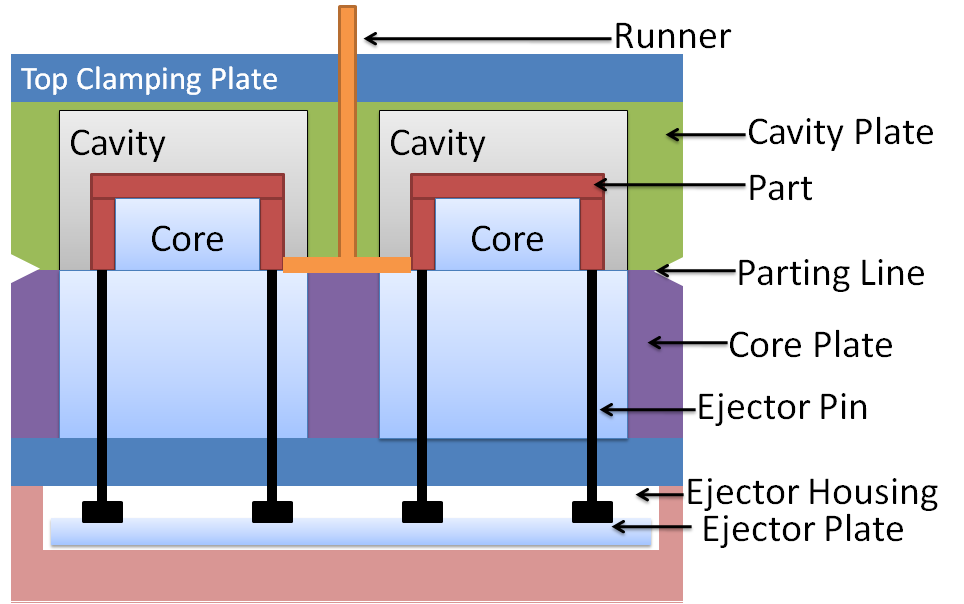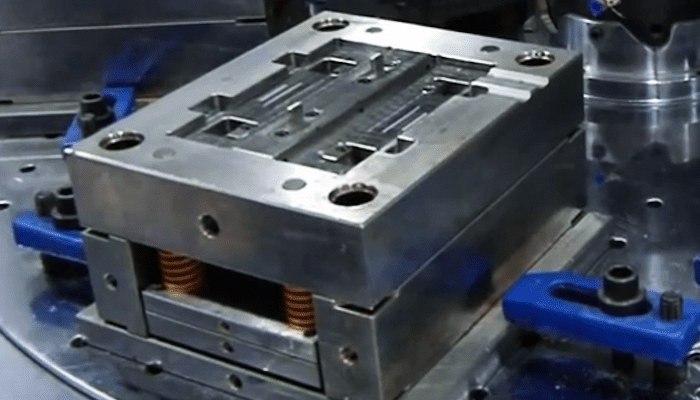What is Two Plate Mold?
Two plate mold is the primary and simplest injection mold structure. It has a very straightforward manufacturing process and generally has the fewest number of moving parts. Two plate mold splits into a movable half and fixed half when the mold opens. The movable half is attached to the moving platen on the injection machine. In contrast, the fixed half is attached to the stationary platen on the injection machine (where the resin is ejected).
In the structure of two plate mold gates, sprue, runners, and cavities are all on the same side. In a multi-cavity two-plate mold, gates and runners must be in the parting line to be easily ejected when mold splits.
Advantages of Two Plate Mold
- Shortened molding cycle and long life span
- Simple design and easy to operate
- Cheaper to manufacture than three-plate mold
- More comfortable to select gate location and shape
- Minimal operational difficulties & less maintenance
- Best for single cavity mold
- Professional not required for repairing
- Significant for reducing the cost of raw materials
Disadvantages of Two Plate Mold
- Gate cutting requires equipment.
- Not suitable for high-quality parts
- To achieve an acceptable surface appearance is costly.
- Must align the parting line with the gate in the multi-cavity two-plate mold.
- Molten plastic flow balancing is difficult in the multi-cavity two-plate mold.
- The problem of short-shot exists in the multi-cavity two-plate mold.
- Additional processing is required to eliminate the gate of all two-plate molds except the banana and the submarine gate.
Structure of the Two Plate Mold

The two-plate mold is the most reliable and straightforward injection mold structure. It consists of two main parts, sides A and side B. When it is loaded in an ejection machine for molding purposes, side A remains fixed, while side B is movable. We have listed down the key components involved in the structure of the two plate mold.
- Core and cavity: these are the shaped sections in either half of the molding machine, giving the plastic product its final shape. The design of the cavity and core is essential in the exact formation of the product.
- Sprue Bush: this component allows the material to enter the mold.
- Return Pin: this is usually made of SKD61 and helps to protect the injection mold from damage. It also pulls back the ejector pin before the mold close.
- Guide Bush/Guide pin: these are designed for precise guiding.
- Support Pillar: it supports the B side plate to avoid bend under high injection pressure.
- Ejector Guide Pin: during ejection, it works as a guide and ensures the ejection is correct.
- Located ring: it is usually made of S55C and works to find the filling hole between sprue and nozzle.
- Cavity Plate: it allows attaching a cooling system, runner system, and guiding pin and makes the product’s appearance.
- Core Plate: it allows attaching cooling system and ejector system and helps make the product’s structure. It is usually made of hardened hot die P20 steel and used to create hollow portions in the plastic components by projecting the core plate into the cavity place.
- Top Clamping Plate: this plate is used to attach the bolt, locate ring, and sprue bush. The top clamping plate holds the mold’s fixed side and connects with the injection machine’s fixed plate.
- Bottom Clapping Plate: this plate is used to hold the moveable side of the mold like cavity plate, spacer block, ejector system, and support plate to the movable platen of the injection machine.
- Core Back Plate: It acts as a stiffener and holds the core to insert in place. It is usually made of mild steel.
- Spacer Block: this component is mounted between the movable cavity plate and the movable clamping plate to give space and allow the ejector plate to move when ejecting the parts.
- Ejector Retainer Plate: Holds and returns the ejector pins in place.
- Cavity Retainer Plate: this plate is also called a force-retainer plate, and it is specifically used to hold the forces and cavities in a mold. Such plates are placed at the mold’s parting line and usually contains the bushings and guide pins.
- Core Retainer Plate: this helps to mount the core on top or recessed into this.
- Sprue Puller Pin: it is used to pull the sprue out of the bushing when the mold is opened. It also helps to run the mold fully automatically.
- Stop pin: it helps to reduce the contact surface between clamping plates and ejector plates. It can easily control the flatness of ejector plates as well.
- Ejector pin: this is used to apply a force to eject a part from the mold. These are also called the “bouncers” of the injection molding world.
- Ejector Sleeve: An ejector sleeve in a two-plate mold is used to eject either an entire finish molded piece part or apply ejection force to some portion of the molded piece to support a part ejection.
How Two Plates Mold Work
- Two plate mold is widely used for low-cost plastic parts. It consists of a cavity and core, split at the parting line and opens in a single-stage operation.
- In this mold structure, the gate and runner must be aligned at the parting line, which helps the runner come out when a part is ejected and requires a separate process to break it.
- The injection-molded product and runner remain on the moving side after molding. The ejection system and product are ejected off from the same parting surface.
- And the movable mold side containing the ejection system pushes the products away after opening the mold. Two plate mold is a simple and cheap option; that’s why it is not suitable for the high-precision part.
Summary
Two plate mold is the simplest injection mold structure and has many benefits and drawbacks. However, if the part is damaged in the inner structure of products, and there is no chance that it will catch the customer’s eye, then a two-plate mold can mold that part. Two-plate mold also allows us to achieve a good finish, but it needs proper design and a professional mold maker.


